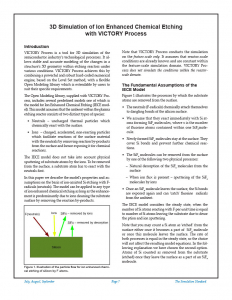3D Simulation of Ion Enhanced Chemical Etching with VICTORY Process
Introduction
VICTORY Process is a tool for 3D simulation of the semiconductor industry’s technological processes. It allows stable and accurate modeling of the changes in a structure’s 3D geometry within etching reactors under various conditions. VICTORY Process achieves this by combining a powerful and robust hard-coded numerical engine, based on the Level Set method, with a flexible Open Modeling library which is extendable by users to suit their specific requirements.
The Open Modeling library, supplied with VICTORY Process, includes several predefined models one of which is the model for Ion Enhanced Chemical Etching (IECE model). This model assumes that the ambient within the plasma etching reactor consists of two distinct types of species:
- Neutrals – uncharged thermal particles which chemically react with the surface.
- Ions – charged, accelerated, non-reacting particles which facilitate reactions of the surface material with the neutrals by removing reaction by-products from the surface and hence exposing it for chemical reactions.
The IECE model does not take into account physical sputtering of substrate atoms by the ions. To be removed from the surface, a substrate atom has to react with the neutrals first.
In this paper we describe the model’s properties and assumptions on the basis of ion-assisted Si etching with F-radicals (neutrals). The model can be applied to any type of ion enhanced chemical etching as long as the enhancement is predominantly due to ions cleaning the substrate surface by removing the reaction by-products.
Note that VICTORY Process conducts the simulation on the feature-scale only. It assumes that reactor-scale conditions are already known and are constant within the feature-scale simulation domain. VICTORY Process does not simulate the conditions within the reactor-scale domain.



